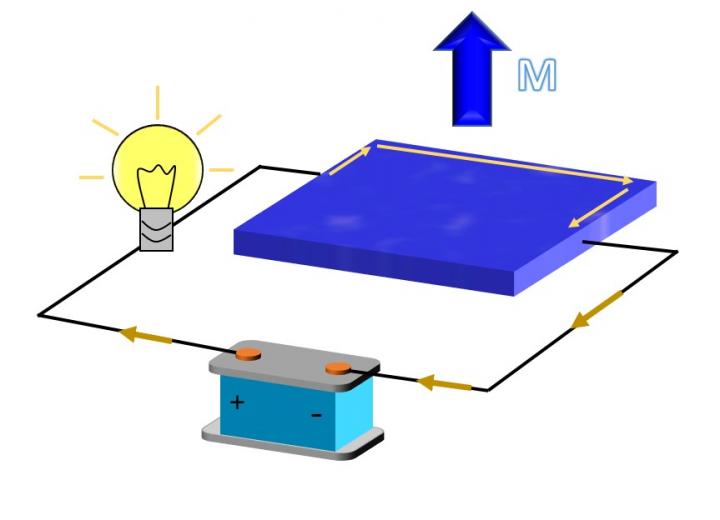Rutgers-led research could lead to more efficient electronics

An exotic magnetic insulator conducts electricity along its edges without energy loss. The M stands for magnetization of the magnet. Credit: Wenbo Wang/Rutgers University-New Brunswick
A Rutgers-led team of physicists has demonstrated a way to conduct electricity between transistors without energy loss, opening the door to low-power electronics and, potentially, quantum computing that would be far faster than today's computers.
Their findings, which involved using a special mix of materials with magnetic and insulator properties, are published online in Nature Physics.
“This material, although it's much diluted in terms of magnetic properties, can still behave like a magnet and conducts electricity at low temperature without energy loss,” said Weida Wu, senior author of the study and associate professor in the Department of Physics and Astronomy at Rutgers University-New Brunswick. “At least in principle, if you can make it work at a higher temperature, you can use it for electronic interconnections within silicon chips used in computers and other devices.”
Study co-authors in China combined chromium and vanadium as magnetic elements with an insulator consisting of bismuth, antimony and tellurium. When electrons in this special material are aligned in one direction – like a compass needle pointing north – an electric current can only flow along its edges in one direction, leading to zero energy loss. That means electricity could be conducted between transistors within silicon chips used in computers and other electronics with maximum efficiency.
Current silicon chips use primarily metal for electrical interconnections in transistors, but that leads to substantial energy loss, Wu said.
The scientists demonstrated the uniform alignment of spinning electrons in the special magnetic insulator – called the quantum anomalous Hall insulator. It conducts electricity without energy loss when the temperature is close to absolute zero: minus 459.67 degrees Fahrenheit. Next steps would include demonstrating the phenomenon at a much higher and more practical temperature for electronics, along with building a platform for quantum computing.
###
The study was led by Wenbo Wang, a physics doctoral student in Rutgers' School of Graduate Studies. Co-authors include scientists at Tsinghua University and the Collaborative Innovation Center of Quantum Matter, both in Beijing, China.
Media Contact
All latest news from the category: Physics and Astronomy
This area deals with the fundamental laws and building blocks of nature and how they interact, the properties and the behavior of matter, and research into space and time and their structures.
innovations-report provides in-depth reports and articles on subjects such as astrophysics, laser technologies, nuclear, quantum, particle and solid-state physics, nanotechnologies, planetary research and findings (Mars, Venus) and developments related to the Hubble Telescope.
Newest articles

First-of-its-kind study uses remote sensing to monitor plastic debris in rivers and lakes
Remote sensing creates a cost-effective solution to monitoring plastic pollution. A first-of-its-kind study from researchers at the University of Minnesota Twin Cities shows how remote sensing can help monitor and…

Laser-based artificial neuron mimics nerve cell functions at lightning speed
With a processing speed a billion times faster than nature, chip-based laser neuron could help advance AI tasks such as pattern recognition and sequence prediction. Researchers have developed a laser-based…

Optimising the processing of plastic waste
Just one look in the yellow bin reveals a colourful jumble of different types of plastic. However, the purer and more uniform plastic waste is, the easier it is to…


